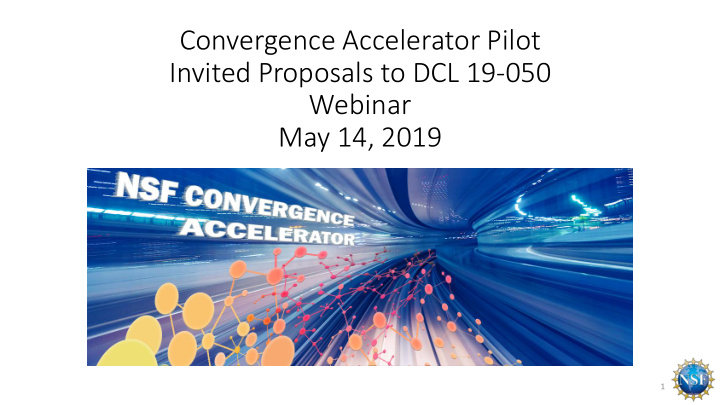



Convergence Accelerator Pilot Invited Proposals to DCL 19-050 Webinar May 14, 2019 1
Webinar Administrative Logistics • Attendees will be in listen-only mode. • Use WebEx Q&A to submit questions to “All Panelists” for reply during the webinar. • View real-time captions at: https://www.captionedtext.com/client/event.as px?EventID=4009941&CustomerID=321 • The presentation slides and webinar recording, will be available at: https://www.nsf.gov/od/oia/convergence- accelerator/index.jsp as soon as available. FAQs are already there! 2
Overvie iew of Webinar • What is expected in your phase 1 full proposal? • DCL 19-050 elements • RAISE • PAPPG • Email NSF proposal number to C-Accel@nsf.gov • How to submit through FastLane • Questions 3
What is is expected in in your Phase I I Full Proposal - DCL 19-050 050 • Track Relevance. Explain how your idea addresses a track as described in the DCL • Deliverables. Discuss the practical applications or useful results that you will develop in Phase II • Partnerships. Describe the different types of organizations that are part of your team and their roles in developing deliverables • Convergence. Explain the intellectually distinct disciplines that are part of your team’s convergent research approach • Project Personnel Table . List all PIs, Co-PIs and Senior Personnel and their affiliations. EXCEL file as a supplemental document. 4
What is is expected in in your Phase I I Full Proposal - RAIS ISE • Two Letters must be uploaded • “Invite letter 1” • “RCO xxxx Invite letter 2” • Your proposal must discuss a convergent research approach involving two or more intellectually distinct disciplines 5
What is expected in your Phase I I Full Proposal - PAPPG • Budget up to $1M for effort Sept. 2019 – ~May 2020 • You may have a waiver to for a PI/co-PI to have more than 2 months of salary • Participant support costs are allowed – those do not bear overhead costs • Budget for three in-person trainings, assume $2,000 per person per training • Your spending timeline should consider • Pitch competition ~March 2020 • Phase II Awards ~May 2020 • Collaborators and Other Affiliations – must be provided for all PIs/Co-PIs and for all Senior Personnel • Letters of Collaboration are allowed • Please submit your Project Personnel Table in EXCEL spreadsheet format as a supplemental document 6
How to Submit Via ia FASTLANE • Input information for the lead (grantee) organization • If the lead organization has NEVER received NSF funding, let us know NOW. On the COVER SHEET • Click the Program Announcement/Program Description button • Scroll to the bottom of the list for PDs and select PD 19-096Y Convergence Accelerator • Select the NSF Unit Consideration button • Division : Select Office of Integrative Activities (OIA) • Program : Select Convergence Accelerator - two track possibilities: • TRACK A1 = CA-HDR: Convergence Accelerato (HDR = Harnessing the Data Revolution) • TRACKS B1 & B2 = CA-FW-HTF: Convergence Accler (FW-HTF = Future of Work at the Human Technology Frontier) • Click the “back” button at the bottom on the screen and select “go” button for Remainder of the Cover Sheet • Near the bottom for Type of Proposal , select the RAISE mechanism from the drop down menu 7
Email il your proposal number to us! • FASTLANE will generate a proposal number and will send a copy of your proposal to you as a pdf, with the number at the top. • This is the final number generated AFTER you submit. Please do not send us the temporary number generated while you are still preparing the proposal. • Send an email to c-accel@nsf.gov that tells us: • The proposal number assigned by NSF on the PDF • The PI • The Title • Why? • So your proposal will be routed correctly! 8
C-Accel Pilot Timeline Phase I: Proposals Research Concept Projects Pitch Team formation Due Outlines Start Competition and research plan June 3, 2019 Target April 15, 2019 Q3 2019 Q1 2020 Blue Ribbon development Panel Projects Proposals Phase II: Deliverables Due Start Creating Q1 2020 Q2 2020 deliverables Q2 2022 9
What happens during the Pilot’s Phase 1? • 6-9 months in duration • Build project teams and partnerships • Create research and development plans • Move towards proof of concept • Cohort activities (training and collaboration) • Pitch competition at end 10
Track A1 • Part of Harnessing the Data Revolution Big Idea • Open Knowledge Network . Create a nonproprietary shared knowledge infrastructure, with a particular focus on publicly available U.S. Government and similar public datasets. Challenges include underlying representation of facts, services that perform reasoning tasks, and secured access. Domains include geosciences, education, smart health, and manufacturing. 11
Track B1 • Part of Future of Work at the Human-Technology Frontier Big Idea. • AI and Future Jobs . Develop tools to link workers with future jobs, reflecting the need for reskilling and lifelong learning. Components include predictive AI, labor market analyses, and educational technology. May focus on particular industries or regions, populations, or types of workplaces. Ethical and fair treatment of workers is essential. 12
Track B2 • Part of Future of Work at the Human-Technology Frontier Big Idea. • National Talent Ecosystem . Innovative approaches for employers to support workers seeking the skills required for 21st century work related to data science, predictive analytics, AI/machine learning, and other technologies of the future. Prototypes of learning environments, platforms, interfaces, or simulations, tools for analysis, assessment, or prediction, and vehicles for recruitment and engagement, with potential for take-up by industry. 13
Thank you! • Use WebEx Q&A to submit questions to “All Panelists” for reply during the webinar. • The presentation slides and webinar recording will be available at https://www.nsf.gov/od/oia/convergence-accelerator as soon as available. • The FAQs are at https://www.nsf.gov/od/oia/convergence-accelerator • Email contact address: C-Accel@nsf.gov . 14
Recommend
More recommend